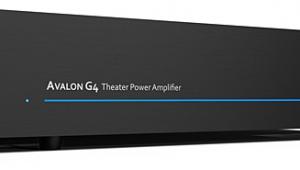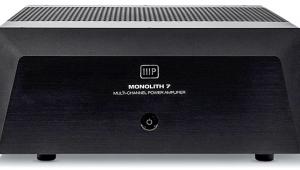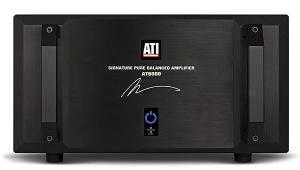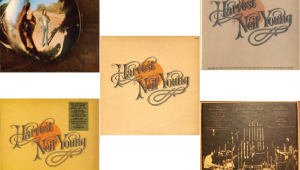Primare SP31.7 & A30.5 Mk.II surround preamplifier-processor & 5-channel amplifier Page 2
Mute on the C31 is in what seems a randomly chosen location: about halfway down from the top left, two buttons below Volume Down. Finding that quickly in the dark when a commercial comes on or the phone rings is an exercise in frustration. On the C20, Mute is in a different location again: top right, just below Standby. The C31's ergonomic design needs a major re-thinking, with function given priority over form.
Performance
Keeping in abeyance my annoyance with the SP31.7's remote control, I began listening to the SP31.7–A30.5 Mk.II combination with multichannel SACD and DVD-Audio recordings. It didn't take me long to conclude that, while ergonomics may not be the SP31.7's strong suit, sound quality is.
Although I have a number of multichannel SACDs and DVD-As, and I've had several suitable players in my system, my experience with these formats has not convinced me that surround sound represents a "must-have" enhancement of music listening. (This is why I maintain separate 2-channel and home-theater systems.) But listening to multichannel recordings through the SP31.7 and A30.5 Mk.II, with the Marantz DV-8400 universal player serving as the source, I came closer than I ever had to feeling that multichannel can be more than a gimmick, and may indeed represent the next logical step for music reproduction in the home.
I think much of my more positive response was a function of the pristine sound quality of the Primare pair. Functioning as just a 6-channel analog preamplifier, the SP31.7 had the sort of clean, open, detailed but nonfatiguing quality that characterizes high-end stereo preamps, and these characteristics were fully matched by the A30.5 Mk.II. Well-recorded multichannel SACD releases such as Vodka and Caviar (Delos DS 3288) were particularly impressive, with SACD's extra resolution evident in the natural quality of the highs and the format's multichannel aspect used to produce not an orchestra-all-around-you effect but a more convincing sense of ambience. I also enjoyed the set of DVD-A releases recorded in "purist" manner by AIX Records (e.g., Stravinsky & Ravel, AIX 1339AX).
For CDs and other 2-channel material, the SP31.7 offers several modes that synthesize a surround-sound effect. I generally prefer my 2-channel straight up, but for some pop material, Dolby Pro Logic II in one of its variants (PLII C for movies, PLII M for music) added a pleasant enhancement without the sort of phasiness that characterized earlier attempts to synthesize surround sound.
Of course, the main use of a surround preamp-processor is for movie soundtracks, and the SP31.7's performance in this realm was impeccable. The sound with DD 5.1 and DTS retained the clarity—if not quite the treble openness and ease—that was evident with bypass high-resolution audio sources. Well-recorded movie soundtracks, such as Harry Potter and the Chamber of Secrets, had the combination of image specificity and a "wraparound" sense of ambience that characterize the state of the art of surround processing.
The combination of SP31.7 and A30.5 Mk.II was a synergistic one, the A30.5 passing along to the speakers the SP31.7's sense of openness and transparency. While my Dunlavy SC-I speakers are not particularly difficult loads, there was a sense of ease at high levels that suggested considerable power in reserve. I can't say exactly what contribution the A30.5 Mk.II's "quintuple-mono" construction made, but I suspect that the imaging specificity I heard with the SP31.7 and A30.5 was at least partly due to the A30.5 having very little crosstalk between channels.
Watching DVDs and HDTV programs on my newly installed, 100-inch-diagonal Stewart FireHawk screen and Marantz VP-12S2 DLP projector has made me more sensitive than ever to differences in video quality, and one feature of the SP31.7 I looked forward to checking out was the claimed purity of its 500MHz-bandwidth video path. Using the Bell ExpressVu 6000 satellite receiver (HDTV programs) or the Marantz DV-8400 DVD player, I could see no difference in picture quality between a direct component-video connection to the projector and routing the signal through the SP31.7. However, a component HDTV connection does result in a slightly softer-looking picture on the Marantz projector than a direct RGB connection (as we noted in our May 2003 review). Nor was the DV-8400's component output as crisply detailed as its DVI output. As the latter output mode gains popularity, I would expect that future generations of pre-pros will incorporate DVI/HDMI switching.
Comparison and Conclusion
The product that I consider to be the benchmark in the $3000–$4000 preamp-processor range is Sonic Frontiers' Anthem AVM 20. Upgraded with a new DSP board and new firmware since the version I reviewed, the AVM 20 costs $500 less than the Primare SP31.7 and offers much more in the way of features, including an AM/FM tuner, an excellent headphone amp, a choice of bypass or A/D conversion on its multichannel inputs, group-delay control of audio signals, THX processing, and two additional zones. Its ergonomics, including a well-thought-out remote with backlighting, are far superior to the SP31.7's. The AVM 20 is a formidable performer, and its success in the marketplace is well-deserved.
In terms of pure sound quality, however, I give the nod to the SP31.7. This is not to negate the AVM 20's considerable achievement: its combination of features, sound quality, and value will be the sweet spot for most home-theater fans. Where I found the SP31.7 to be superior was in providing more of the fine detail and transparency that characterize high-end audiophile preamps. While its remote leaves a lot to be desired and its feature set is not as complete as the AVM 20's, the SP31.7 would be my first choice if sound quality were the overriding consideration.
The Primare A30.5 Mk.II 5-channel amplifier obviously has solid engineering behind it, and goes about its business in an unobtrusive, highly competent way, doing everything asked of it. It's an excellent mate for the Primare SP31.7. If you're in the market for components that combine sleek styling with first-rate sound quality, you'd find it difficult to do better than this combo.
- Log in or register to post comments



































































